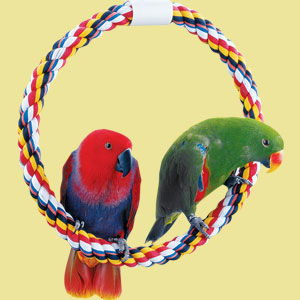
Choosing a Perch for your Bird
If you spent all day, every day on your feet, you would probably make numerous investments to prevent your feet from hurting—expensive shoes, arch supports, and the occasional foot massage. Your bird spends almost all of his time on his feet; therefore, foot health is crucial for his overall health. One important method that greatly affects foot health is the use of perches.
Bird owners can find it difficult to find the right sized perch, especially because there is such a variety of perches. There are numerous aspects concerning perches that you have to take into account—the diameter of the perch, the material of the perch, and the variety of the perches. Below are a few guidelines that you can follow to help you decide which perches are right for your bird.
How to Choose
What Diameter Should a Bird Perch Be?When trying to find the right sized perch for your bird, remember that your bird's toes should wrap around the perch but not touch each other. If the perch is too big, he can end up with pressure sores and fall off his perch while sleeping. Your bird's foot should wrap 75 percent around a perch for ideal safety and comfort. Keep in mind your bird's length because his tail will become ratty if the perches are placed too close together.
What Are Bird Perches Made Out Of?
Different materials used to make bird perches include wooden, plastic, concrete or sand, calcium and cuttlebone, bee pollen and calcium, rope and orthopedic. Rope perches are often a source of comfort for birds because they are a soft place to perch on. However, be aware of loose threads that your bird might try to eat or catch a toe on. Plastic perches can be fun and interesting, but they are often very slippery and harmful if ingested. Concrete or sand perches are perfect for nail trimming and beak conditioning. Birds usually prefer to sleep on these perches, so be sure to put one in a high spot in their cage. Orthopedic perches are oddly shaped to encourage birds to use all of their foot muscles.
Why Do Birds Need Different Perches?
You probably own numerous shoes for a variety of occasions and purposes. Similarly, your bird needs a variety of perches for different purposes. The difference surfaces, textures, and diameters will encourage exercise and proper trimming of the beak and nails. It will also help prevent boredom and imitate your bird's natural environment. Three perches is an ideal number for one bird.
Tips for Choosing a Bird Perch
Remember that birds see height as security, so they will tend to sleep and spend a lot of time on the highest perch. Therefore, you should ensure that the highest perch provides maximum comfort and follows the 75 percent guideline. On the other hand, grooming perches should have a slightly larger diameter so that your bird's nails make contact with the abrasive surface. Your bird's feet should reach about halfway around a grooming perch.
Remember to place perches in a variety of locations. Place one perch by the door so you can easily put your bird back into his cage. Place one perch at the bottom to encourage your bird to use the whole cage. However, do not place perches directly above your bird's food because his droppings will likely fall into his food. Another tip is to not overdo the number of perches within your bird's cage, or you may inhibit his ability to move around. Lastly, be sure to keep perches clean, as a dirty perch could lead to foot infections.
Ensure that your bird has access to various perches to provide ultimate foot health. Variety is important in your life and in the life of your bird!
Discover More!
How to Make Bird ToysMy First Bird: What Will My New Bird Need?
Make Your Bird's Toys Last Longer
Benefits of Foot Toys for Birds
Return to Bird Articles


